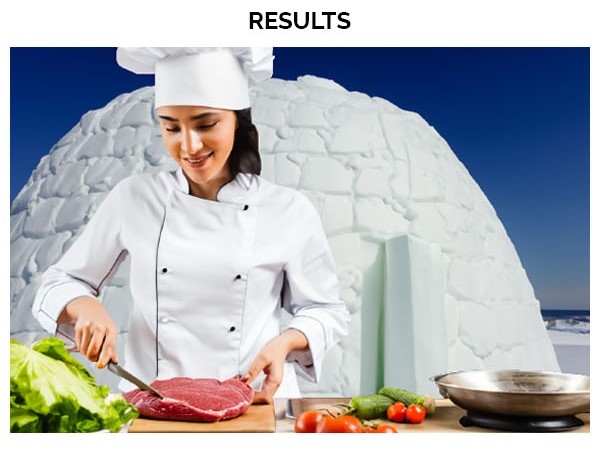
In Part 1 of this blog I shared a headline exercise we did to show how AI can assist with marketing efforts. Below is the continuation of this theme, this time focused on art generation and the things we must all be cautious of when utilizing AI in our marketing efforts.
There are a growing number of AI tools that will help you in generating art. Some exist where you can request an image that shows your subject matter, but you dictate the art style and more. For example, in the latest version of Adobe Photoshop®, there is a generative AI function that allows users to create new images and add, remove or change elements in existing images with a few simple clicks.
To demonstrate how this works, we asked the AI tool to generate an image of a chef cooking a steak with an igloo in the background. Would I use this image as is? No way. We don’t know whose face this is or if we have permission to use it. And depending on the purpose of the image (say training vs. promotion), the way she is holding the knife and preparing to cut AI generated “steak” might spark negative or detracting conversations. But using AI to help ideate a creative concept you want to test before you have the talented, real professionals work on it can save time and budget.

The Watch Outs
When using AI, particularly when generating new content or images, it’s important to understand the tool’s limitations. Here are four big ones:
- Relevance: The free version of ChatGPT (and any tool that utilizes GPT-3.5) is currently only trained on the internet up until June 2021 – it doesn’t know anything that has happened in the world since then. One area this really stands out is in the progress being made in sustainability. ChatGPT doesn’t know about the newest emissions research and technology. It doesn’t know about regenerative agriculture either. There is a paid version of ChatGPT users can access that is updated with new information regularly and has access to beta features.
- Prompts: How you prompt the AI is critical. It is part art and part science. If you don’t know how to best construct a prompt, you highly increase your chances of getting erroneous information back. If it doesn’t have context, though, it’s been found to just make things up. AI is a tool. And like all the other tools used in marketing, it’s critical to have a good marketer who understands the limitations of the software and the context of your business to help you best utilize the tool. The saying “garbage in, garbage out” definitely applies here.
- Ownership: There’s also the question of who owns what – who owns the prompts (or data) you put into the tool and who owns the results that it spits out. Until everything is settled in this area, be cautious with what you input and how you use it.
- Permanence: What you put in, stays in. Never input strategic documents, brand materials or confidential information in a public system. While the output could be closer to what you want, you could be putting your intellectual property in jeopardy.
Before I wrap up, it is important to take a moment to talk about the fact that any AI tool can have a dark side. I suspect we will all learn that quickly in 2024, given that it is an election year. We’re likely to see AI-generated images, videos, text clips and more. The information, misinformation and disinformation pipelines could become even more confusing. So, while it can make it possible for us to generate an image of a chef cooking a steak by an igloo more feasible and cost-effective than ever before, we have to understand the ways that same tool can be used to harm others.
AI tools will absolutely change our world. In marketing, we are already using them to optimize campaigns to get the highest return on investment and to simplify and streamline processes. The same will happen in the meat industry and many, many others. But understanding the capabilities and limitations of these tools is critical to proper use and positive outcomes.
